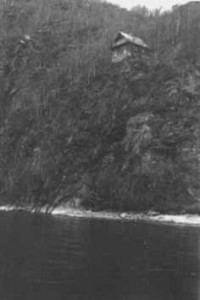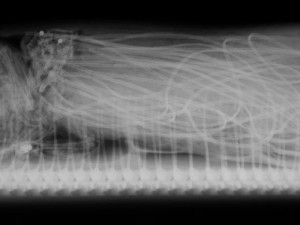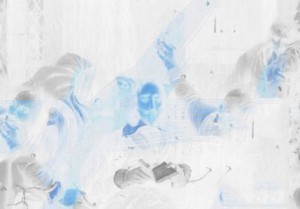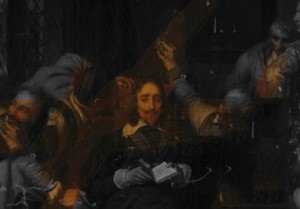Preamble: the flood
As we witness the fireworks of global finance exploding in the sky, together with the narratives and hopes of the last three decades, we might be missing the silent activity that swarms around our feet. On the muddy ground of today’s semiotic life, the sudden lack of our attention to the moves of semiocapitalism has not led to any slowing of its processes of transformation of our internal and external environments. Language, affects, emotions, attention and meaning continue to be subsumed by the production system, maybe now more than ever. They are extracted from us in rivers, they are conveyed into the catching areas of Capital, and then stored within the mighty dam of Marketing. There, they are supposed to work by inertia, pushing the engines of economic production with their sheer weight. It used to be called the advertising circle, then it became the totality of semiocapitalism.
In particular, people seem to be relieved by relinquishing ownership on functions of production and management of abstractions. They have been encouraged to do so for decades, endlessly urged by marketing to get rid of their heavy burden of immateriality and to give it to the experts. The experts, however, have promised more that they can deliver. The level of the flow keeps increasing, much faster than the construction of the dam that contains it. As more and more semiotic functions are handed over by individuals to the marketeers, their sheer amount is ultimately overwhelming them, escaping the rigid grids that had been built for their containment, overflowing, becoming floods. As it is in the nature of floods, they change the tamed, useful nature of water-for-consumption into the unusable, and potentially threatening qualities of water-in-itself.
And yet, from the devastating indifference of floods, many a civilization has risen.
From description to incarnation
The ultimate scope of marketing is increasing the sales figures of a certain product, a line of products, a brand or a network of brands. This scope can be reached through a myriad of paths and techniques, following short-term and/or long-term strategies. One of the main marketing strategies is promotion, that is, the provision of information about a product /brand(truthful or not, actual or virtual, it does not matter) to the potential customers. Promotion reaches its pinnacle in the use of the techniques of advertising.
In the second half of the 19th century, advertising started as the mere description of the qualities and properties of the objects for sale. Ads merely described the qualities of the products, possibly presented in emphatic terms. Around the second decade of the 20th century, and especially with the first encounters of art and advertising (as it happened with Futurism), advertising started developing the semiotic aspect of promotion. As it became even clearer at the end of the 1950s, advertising focused more and more on the semiotization of the products, through the insertion of values (that is, of the representation of abstract ideas) into them. The product became the symbol of a certain idea, that is, it acquired semiotic value. Through use, the purchaser could interact with the abstractions represented by the product, and appropriate them for him/herself. For example, if a bottle of shower gel represented ‘cleanliness’, the interaction of the individual with that product would lead him/her to appropriating the noun ‘cleanliness’ through its transformation into the adjective ‘clean’. Through use, the ideas represented by the product would transfer to the user and, in doing so, the user would transform objective values (nouns, represented by the products) into subjective attributes (adjectives, acquired by the individual)
In the 1990s, marketing paired advertising with experiential techniques. The interaction between individual and product changed. The appropriation of the ideas represented by the object would no longer happen through simple use, but had to unfold according to the rules of an experience. As defined by marketing, an experience is a ritual set of strictly normed actions, which ultimately leads to the magic appropriation by the individual (or individuals, in the case of collective rituals) of the ideas represented by an object. Differently from use, experience expands its normativity beyond the simple interaction between user and object, going to cover the setting of the surrounding environment, the relationship between the user and other users, the relationship between that specific experience and other specific experiences, and so on.
During the early 2000s, another transformation took place. It was as if advertisers had decided to react to the increasing prestige of experience-managers, by giving new legitimacy to their dying art. In their presentation of the product, advertisers transformed the values contained within it into functions. As opposed to a value, which is the representation of an abstract idea, a function is the process of performance of that idea. A function is the endless process of transformation of the noun into the adjective. In the past, such functions were performed by individuals through use of the products, while, in this new presentation, products already perform the use process within themselves, that is, they already, by themselves, digest the ideas they once used to merely represent and provide their buyer with ready-made subjective attributes which s/he can appropriate as his/her own. If, in the 1960s, a shower gel contained ‘cleanliness’ and, though use, made the individual ‘clean, the same shower gel in the 2000s would already be ‘clean’ in itself, and would pass this ready made adjective to its user. It is worthy noticing that, because of their internalized functions, the 1960s users created each one for him/herself his/her specific way of being clean, while the 2000s users would all participate equally to the same ‘clean’ attribute, as pre-constructed by the product.
Of course, this appropriation still has to unfold according to the rules of a ritual experience, rather than those of simple use. Only the precise obedience to the rules of the ritual makes it possible for the user to appropriate the output of the function constantly in progress within the object. For example, although a pair of nike trainers already perform, within themselves, the function of transformation of the noun ‘sportiness’ into the adjective ‘sporty’, through their correct experiential use the purchaser is still able to appropriate the attribute ‘sporty’ as his/her own.
During the last few years, this evolution has gone even further.
On the one hand, individuals have ultimately accepted to relinquish their ownership of virtually all functions of production and digestion of abstract ideas and to give them to the marketing departments. In doing so, individuals have de facto externalized such functions into products, through the mediation of marketing (more exactly, of semio-marketing such as branding and advertising). It is no longer individuals, but objects, who deal with the abstract world of ideas and bring them to Earth.
On the other hand, the permanent exposition of products and brands to the universe of abstraction has transformed them from hosts of the representation of ideas, into incarnations of those ideas. Products and brands now incarnate the abstractions they once used merely to represent. They have evolved even beyond being transformative machines, which digest ideas. Ideas have eventually ‘possessed’ the objects, turning them into their earthly incarnation.
At the same time, the path of experience seems to have ultimately dried up. The interaction between individual and object no longer consents any appropriation by the individual of the ideas contained in the object, nor of their adjective, digested version. The almost perfect coincidence between ideas and objects has closed any possible opening to the insertion of humans within their relationship. The functional cycle happening within the object has finally closed, leaving outside the humans. The object takes the noun of the idea, transforms it into an adjective and finally appropriates this adjective, thus incarnating the idea and simultaneously making itself a subject. For humans, there is nothing left to do but to witness the miracle.
Smirnoff
Let’s take, as an example, a 2008 advert for Smirnoff Vodka. From the bottom of the ocean, with great profusion of CGI, all sorts of objects start to emerge and to fly out of the water. Cans, tins, cars, crashed airplanes, shipwrecked vessels, ruins of submerged civilizations… What’s going on? The camera swiftly moves inside the water, until it reaches the bottom. There, lying on the sand, we find a bottle of Smirnoff. ‘Ten times filtered’ – we read – ‘Extraordinary purification.’
Smirnoff is not just pure. Smirnoff is purity. If you place it on the bottom of the ocean, it cleans up the whole mess down there. If you place it in your house, you have a fragment of purity glowing on your shelf. That’s why you must buy it. But if you drink it… Ah! If you open it…. The magic goes. Purity disappears. You are left with some very common vodka, which is not even that good (incidentally, good quality vodkas need to be filtered only once, while poor quality vodka has to be filtered repeatedly). Why does the magic (and the ideas) disappear the moment the individual interacts with the object?
If we are to attempt to answer this question, we must borrow from religious categories. The ‘incarnation’ which happens in the product has to be taken literally. Smirnoff incarnates purity, like Jesus incarnated God. This means, first of all, that while Smirnoff is purity, purity is not Smirnoff. Smirnoff is ‘the chosen one’ for the incarnation of purity, but it is ultimately replaceable. No inner, specific qualities of Smirnoff make it the best candidate for this task. Similarly, God’s decision to choose Jesus of Nazareth and to make him Christ – him, among all his brothers and sisters – was completely arbitrary. However, once chosen, the object of incarnation ceases to be merely the host of a value and becomes one thing with the idea.
By definition, the contact of the believer with the mystery of incarnation always happens on a non-equal level. Even when conveyed through the magical means of the communion, the immaterial transference between incarnation and simple individual always encounters failure. In the mouth of the believer, the body of Christ necessarily turns into some simple, tasteless wafer. Of course, this impossibility is not to be blamed on the side of the perfect mystery, rather on that of the imperfect believer. It is the inadequacy of the believer, his/her innate shortcoming, his/her natural inability to host the Spirit, which is the reason for such failure. No wonder, then, that the newly evolved world of advertising induces anxious and depressive responses from the consumers. Like the Jewish
and Christian religions, advertising also relies on the idea of original sin, and functions on the perennial begging for forgiveness by the believer. The main difference being, on the one hand, that the god of advertising is neither merciful nor a god of love, and, on the other, that this vengeful god keeps changing the complex rituals which promise (but never deliver) a temporary truce with its believers.
Testimonials of ideology
What can we call those products which no longer represent, but incarnate ideas? Certainly, we can no longer call them commodities. The paradoxes of the mystery of incarnation have turned their use value to nothing, while they have also made impossible the comparison between commodities, which is at the basis of the definition of exchange value. Also, their given market price can no longer be explained as the congealed amount of labour contained within it, as the process of semiotization escapes the normal accountancy of work-hours. Such products resemble virtual currency within the financial system, that is pure and abstract clusters of values. But they are useless currency, since their owners cannot interact with them on any other level but that of possession. For this reason, we can probably define these products as pure reserves of value, as exemplary and pure stockpiling. These products embody that same process of rapture of earthly functions into super-human abstraction which is typical of ideologies. However, these are particular types of ideologies.
While typical ideologies, such as those who had such great success during the 20th century, still required the active intervention of humans in order to take place outside of the realm of ideas, these new ideological constructs require less and less human participation. They simply require the proclamation of faith which is implicit in the act of purchase by the consumer of the incarnated object, and his/her subsequent guarding of the sacred object through a possession which never involves use. Buyers of such products no longer are users, but witnesses. They behold the fragments of ideas that they have purchased and they witness their perfect functioning outside of any possible human intervention.
There is only one category of individuals who can still claim the possibility of interacting with incarnated products. While they are still technically humans, they really are not. They are testimonials in advertising. They are often chosen among celebrities, but can also be random, beautiful people who were raptured into the world of direct relationship with the idea. Their relationship with incarnated products is of the object-to-object type – which is the reason why it can still function. When a testimonial interacts with an incarnated product on a TV screen or on a billboard, the transference of values actually happens. When the testimonial of l’Oreal uses l’Oreal’s shampoo, s/he actually becomes more beautiful, s/he actually ‘is worth it’ – as the slogan goes. When a testimonial eats organic food, it actually makes him/her healthy. While, for a non-raptured consumer, organic food functions (that is, performs the ‘health’ function) only as long as it is kept locked inside the refrigerated safety box in the kitchen.
It is as if the church of consumerism had turned from the catholic spectacle of opulence and participation, into a (modified version of) the orthodox mystery. In Greek orthodox churches, priests perform most of their actions behind a wall, which separates them from the community of the believers. Testimonials, like orthodox priests, enter in contact with the mystery of incarnation in a place that is separate from the crowd attending the mass, to whom they turn their back. However, in the church of consumerism, someone has placed a mirror in that separate room, and the believers can still see the reflection of the priests participating in the mystery. This mirror is capitalism, that is, of possession through purchase, which is the last possible way of witnessing the mystery.
The city of the future
Which position are we to take in the face of these transformations?
I believe that we should welcome the complete closure of the circle of meaning produced by advertising with joyful hearts. By incarnating ideas into objects, late capitalism has given us a parting gift before its coming demise. Once dangerously floating above our heads under the name of ideologies, abstract constructions of absolute values are now trapped within inanimate objects. Capitalism has performed a voodoo trick, for which we should be grateful.
If Smirnoff wants to have the monopoly on the idea of purity, it is most welcome to do so. Actually, we should help it to do it even more. Artists should team up with advertisers, pushing the boundaries of incarnation even further, closing the circle of perfection. So that abstraction might never escape again, and never again swarm above us like a murder of crows. We have battled for centuries against the dangerous power of ideas, and we might finally be reaching victory thanks to the unwitting help of semiocapitalism.
This does not mean that we will ever be able to do without abstraction. The tendency to create absolute, idea values is part of human nature, and a part of us is and always will be longing for the presence of abstraction and ideology within our lives. However, if up until now the ideologies of modernity necessitated our active intervention and sacrifice in order to exist among us, we can now be satisfied by witnessing their presences, trapped within fully semiotized, incarnated products.
We should let the discourse started by the latest form of advertising develop to its ultimate consequences.
Little by little, incarnated objects will take over our living spaces. Like the house of the neurotic, which is immaculate and perfect in order to perform the function ‘calm’ on behalf of its incapacitated owner, our cities will progressively take over all the abstract functions that we always struggled to perform. And like the neurotic, we will slowly realize that if we want our houses to perform those functions, we will eventually have to move out. And we will move out of our houses, out of our cities. The perfect city of the future will be the complete pantheon of absolute abstractions incarnated into objects, devoid of any human eyes. We will enter them in silence, to dust the objects and the glass walls of the skyscrapers. We will have to make sure that everything remains in there as we left it, that nothing ever breaks. And, once a day, we will have to watch the ads for the products trapped in there, which we will no longer need to buy, just to remember that they have taken upon themselves the plague of ideology for our salvation. Then we will go back to our new homes, outside of the perfect city of abstraction, where our worst desires will remain safely locked. And we will be free, forever. Free from Humanity, from Purity, from Beauty, from Health. Free to be human, to be pure, to be beautiful, to be healthy.
This text derives from a conversation with Robert Prouse






